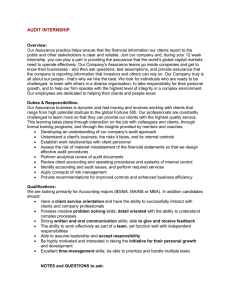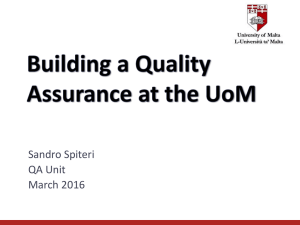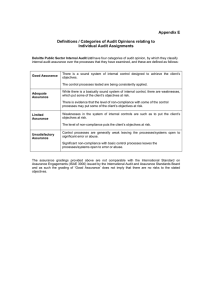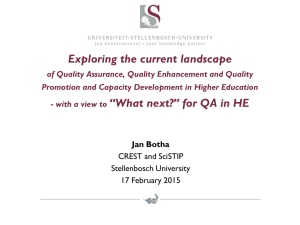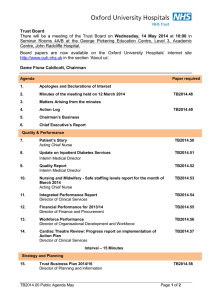Internal and External Quality Assurance in Further and Higher Education
advertisement
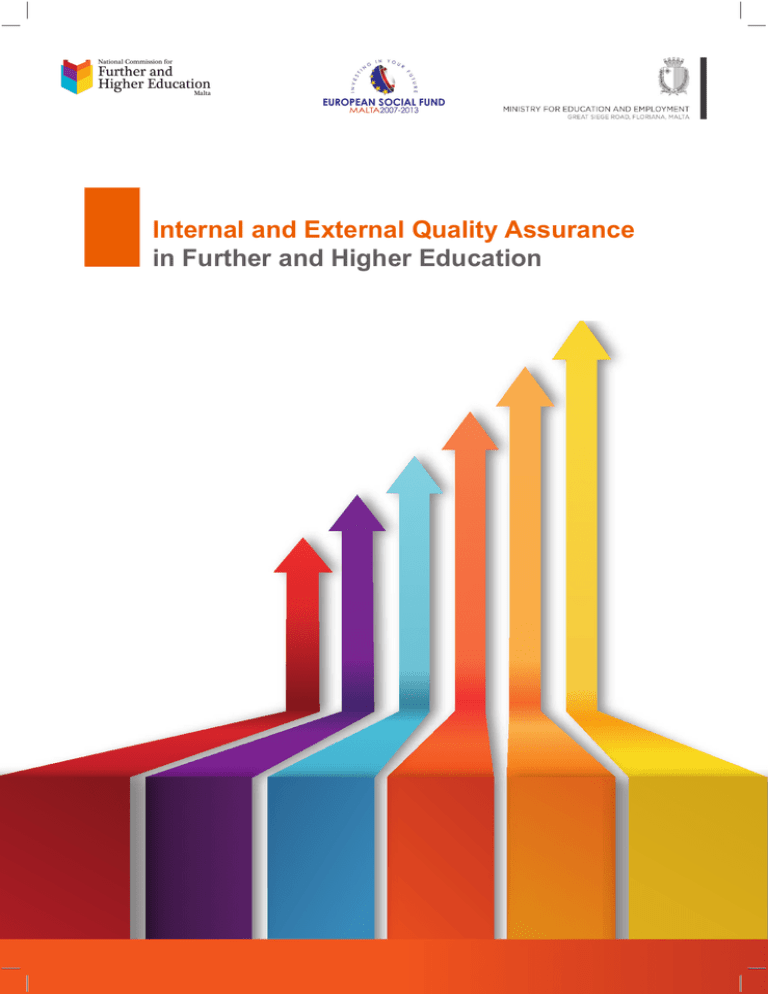
Internal and External Quality Assurance in Further and Higher Education Internal and External Quality Assurance in Further and Higher Education What is Quality Assurance? The National Commission for Further and Higher Education (NCFHE) is the competent authority in Malta for the licensing, accreditation and quality assurance of providers and programmes. Quality assurance aims to safeguard the quality of further and higher education within an internal and external framework of accountability on a national, European and international level. By virtue of Subsidiary Legislation 327.433 the NCFHE has the remit to make and publish guidelines and criteria for the Internal Quality Assurance System (IQA) required by providers. It is also responsible for making guidelines containing the criteria and procedures to be used in accreditation and External Quality Assurance (EQA) activities undertaken by it. The National Quality Assurance Framework for Malta The National Quality Assurance Framework provides guidance to educational institutions that embark on the processes of Internal and External Quality Assurance in order to enhance the learning outcomes provided through their educational programmes. It is underpinned by six principles: 1 2 The Framework is based on the European Standards and Guidelines and enriched by European Quality Assurance in Vocational Education and Training (EQAVET) components that relate more directly to employability according to the Maltese context. The Framework shall contribute to a national quality culture by supporting providers to develop and improve 3 4 their internal quality management systems which are regulated, monitored and supported by external quality audits. It thereby contributes to improved service and an enhanced international profile and credibility for Maltese provision. At the core of the national quality culture is the internal quality assurance process conducted by the educational institution. This may be augmented by an external review that is sought by the educational institution. The third cycle in the quality culture is the external quality audit conducted by the NCFHE. The NCFHE is itself peer reviewed by other quality assurance agencies. IQA should be designed to be fit for purpose according to courses and service users. The Framework shall provide the necessary guidelines for the development of an IQA, whilst allowing for established quality management systems adopted by the educational institution that are in harmony with the Framework. The EQA process shall serve as a tool for development and accountability towards stakeholders, including learners and employers. It shall ensure that the internal quality management system of the educational institution is: -- fit for purpose according to courses and service users; -- compliant with standards and regulations and contributing to the development of a national quality culture; -- contributing to the fulfilment of the broad goals of Malta’s Education Strategy 2014-2024, and Malta’s National Quality Culture 2 -- implemented with effectiveness, comprehensiveness and sustainability. 5 6 The Framework shall revolve around the learning outcomes-based Quality Cycle. The Quality Cycle informs both the learning process of the IQA as well as the developmental perspective of the EQA and its interaction with the IQA. It is the IQA of the educational institution that is the primary driver for enhanced quality and output, assisted by the EQA process. The NCFHE shall act and be seen to act, with integrity and independence in its EQA function, by: -- having autonomous responsibility for its operations; -- ensuring that the conclusions and recommendations made in its EQA reports and the outcomes thereof shall not be influenced by any third parties; Relationship between IQA and EQA The Quality Cycle EQA -- ensuring that the definition and operation of its procedures and methods, and the nomination of its external experts shall not be influenced by any third parties; -- operating a non-conflict-of-interest mechanism in the work of its external experts; and IQA ENHANCED QUALITY AND OUTPUT -- ensuring that while relevant stakeholders, particularly students and teaching staff, are consulted in the course of quality assurance processes, the final outcome of any quality audit or accreditation decision remains its responsibility. The Internal Quality Assurance Standards The National Qualifications Framework has 11 Internal Quality Assurance (IQA) standards. These apply to further, higher and adult formal provision in Malta regardless of the mode of study or place of delivery, including transnational and cross-border provision. In this document the term “programme” refers to the full range of provision, from short courses up to full programmes of study. 1 Policy for quality assurance Educational institutions shall have a policy for quality assurance that is made public and forms part of their strategic management. Internal stakeholders shall develop and implement this policy through appropriate structures and processes, while involving external stakeholders. This should include: -- reference to the relationship between research and learning & teaching, where applicable; respect to quality assurance; -- procedures for ensuring academic integrity and freedom, where applicable; -- procedures for guarding against intolerance of any kind or discrimination against the students or staff; -- the involvement of external stakeholders in quality assurance; -- the organisation of the quality assurance system; -- procedures for the quality assurance of any elements of an entity’s activities that are subcontracted to or carried out by other parties; -- the responsibilities of departments, schools, faculties, institutes and/or other organisational units as well as those of institutional leadership, individual staff members and students with -- in the case of local representatives or franchises of foreign providers, explicit reference to the quality assurance procedures of the parent provider and the role of the local representative or franchise. 3 2 Institutional probity 4 Educational institutions shall ensure appropriate measures and procedures are in place to ensure financial probity. Universities, self-accrediting and higher education institutions, accredited entities that are bodies corporate, and other accredited entities with a turnover of more that €50,000 per annum shall have yearly audited accounts and regular budget plans. These can be on a yearly basis or else on a rolling budget system of up to three years. Other accredited institutions shall have yearly financial statements and regular budget plans. Members of the body corporate, the legal representative and the persons occupying a headship position should be fit and proper persons to deliver further or higher education programmes. 3 assessment Programmes are to be delivered in a way that encourages students to take an active role in creating the learning process, and that their assessment reflects the same approach. The implementation of student-centred learning and teaching shall: -- respect and attend to the diversity of students and their needs, enabling flexible learning paths; -- consider and use different modes of delivery, where appropriate; -- flexibly use a variety of pedagogical methods; -- regularly evaluate and adjust the modes of delivery and pedagogical methods; -- encourage a sense of autonomy in the learner, while ensuring adequate guidance and support from the teacher; Design and approval of programmes Self-accrediting entities shall have processes for the design and approval of their programmes as per the following characteristics: -- promote mutual respect within the learner-teacher relationship. -- define the expected student workload in terms of ECTS or ECVET learning credits; Quality assurance processes for assessment shall take into account the following: -- indicate the target audience and the minimum eligibility and selection criteria, where applicable; -- assessors are familiar with existing testing and examination methods and receive support in developing their own skills in this field; -- are learning outcome-based, distinguishing between knowledge, skills and competences; -- the criteria for and method of assessment as well as criteria for marking are published in advance; -- indicate appropriate learning dynamics and a measure of tutor-learner interaction as is appropriate for the course level and content; -- the achieved learning outcomes are analysed in relation to the intended outcomes - students are given feedback, which, if necessary, is linked to advice on the learning process; -- indicate appropriate resources and forms of assessment; -- where possible and applicable, assessment is carried out by more than one examiner; -- indicate the minimum requirements in terms of qualifications and competences for teaching staff; -- the regulations for assessment take into account mitigating circumstances; -- are in line with the MQF and the Malta Referencing Report 2012 and subsequent updates; -- the process of the identification of training/ programme needs involves the participation of external stakeholders who are likely to benefit from the outcomes of such provision; -- programmes that are employment-oriented involve stakeholders from the world of work in their design and review; -- involve students in their design and review; -- are designed so that they enable smooth student progression; -- are subject to a formal institutional approval process. Other entities accredited by the NCFHE are to follow the programme accreditation procedure of the NCFHE, which shall be in line with this Standard. The current procedure is available on www.ncfhe.org.mt. 4 Student-centred learning, teaching and -- assessment is consistent, fairly applied to all students and carried out in accordance with the stated procedures; 5 -- a formal procedure for student complaints and appeals is in place. Student admission, progression, recognition and certification Educational institutions shall consistently apply pre-defined and published regulations covering all phases of the student “life cycle”, e.g. student admission, progression, recognition and certification. In particular: -- admission processes and criteria are implemented consistently and in a transparent manner; -- induction to the institution and the programme are provided; -- both processes and tools are in place to collect, monitor and manage information on student progression; -- while accredited educational institutions retain the right to determine their own selection criteria, they have mechanisms in place to take into consideration relevant qualifications that are accredited or recognised by the NCFHE, and relevant periods of study and prior learning, wincluding the recognition of non-formal and informal learning; 6 7 -- on successful course completion, students receive documentation explaining the context, Malta Qualifications Framework (MQF) level, amount of learning credit, content and status of the qualification gained, in line with NCFHE regulations. By 2017, locally accredited full qualifications at both further and higher education levels shall include reference to achieved learning outcomes. This shall include: -- profile of the student population, including prevalence of vulnerable groups; -- course participation, retention and success rates; -- students’ satisfaction with their programmes; 9 Public information Educational institutions shall publish information about their activities, including courses/ programmes, which is clear, accurate, objective, up-to-date and readily accessible. This includes: Teaching staff -- the selection programmes; Educational institutions shall assure the competence of their teaching staff. Clear, fair and transparent processes for the recruitment, conditions of employment and professional development are to be applied. Higher education institutions shall encourage scholarly activity to strengthen the link between education and research, where applicable. In the case of part-time teaching staff providing limited and specific services, entities shall ensure that such staff are constantly au courant with developments in their respective fields and with the methodological requirements of their programmes. -- their intended learning outcomes; -- the teaching, learning procedures used; Information management Entities shall collect, analyse and use relevant information for the effective management of their programmes and other activities. for the courses/ and assessment -- the pass rates, and -- the further learning opportunities available to their students. 10 The information available shall be sufficient for prospective applicants to make an informed choice in terms of the knowledge, skills and competences they are likely to acquire on successful completion of the programme. Ongoing monitoring and periodic review of programmes Entities shall implement the Quality Cycle by The needs of a diverse student population (such as mature, part-time, employed and international students as well as students with disabilities), and the shift towards student-centred learning should be taken into account when allocating, planning and providing the learning resources and student support. All resources should be fit for purpose and accessible, and students should be informed about the services available to them. In delivering support services the role of support and administrative staff is crucial and therefore they need to be qualified and have opportunities to develop their competences. criteria -- the qualifications they award, including information on the EQF/MQF level and ECTS/ ECVET learning credits; Learning resources and student support Entities shall have appropriate funding for learning and teaching activities. They should provide a range of resources to assist student learning commensurate to the type and level of course/s. These may vary from physical or virtual libraries, learning equipment, study facilities and IT infrastructure to human support in the form of tutors, counsellors and/or other advisers. 8 -- employment rates and career paths. 11 monitoring and periodically reviewing their programmes in terms of their IQA policy and standards, to ensure that they achieve the objectives set for them and respond to the needs of students and society. Such reviews shall include input from students and, where applicable, input from EQA reports. Students and other stakeholders that are benefitting from the outcomes of the programme are to be involved. In the case of employment-oriented programmes this should also include stakeholders from the world of work. These reviews shall lead to continuous improvement of the programmes. Any action planned or taken as a result shall be communicated to all those concerned. Cyclical external quality assurance Entities should undergo external quality assurance by, or with the approval of the NCFHE on a cyclical basis according to NCFHE guidelines, once every five years. 5 Scope of External Quality Assurance External Quality Audits (EQAs) are carried out under the responsibility of the NCFHE. In making arrangements for EQAs, the NCFHE adheres to the following standards: -- it examines the fitness for purpose and effectiveness of the IQA processes used by the entity, including an examination of the system’s structure, the documentation it produces and the evaluations of quality conducted by the entity; -- it examines the compliance of educational institutions with obligations of licence holders under these regulations, where applicable; as well as any conditions or restrictions imposed by the NCFHE on the licensee under these regulations; -- it includes appropriate investigatory mechanisms to ensure financial probity, and where the provider is a body corporate, to ensure that the members of the body corporate, the legal representative and the persons occupying a headship position are fit and proper persons to deliver further or higher education programmes. Composition of Peer Review Panel The EQA is conducted by a Peer Review Panel selected by the NCFHE and composed as follows: Head of Peer Review Panel A recognised expert in the field of delivery of the target institution, and/ or in EQAs External experts Between one and three, depending on the size of the target entities, being recognised experts in the field/s of delivery of the institution NCFHE QA employees Up to two NCFHE employees, with expertise in EQA procedures Student Up to two students Both the external experts including the Head of the Panel as well as the student evaluators shall be selected according to detailed criteria developed from time to time by the NCFHE according to each category of provider. All Panel participants shall receive appropriate training and induction. 6 Timeline for the External Quality Audit Prior to the EQA Activity Timeline Educational institution applies with NCFHE for a provider audit Before current licence elapses (five years from issue or last audit, unless otherwise specified) NCFHE provides the dates of the audit 30 weeks before audit visit in the field/s of delivery of the institution NCFHE provides information on the proposed Peer Review Panel members 26 weeks before audit visit Education institution identifies the person in charge of quality assurance internally (the Facilitator) 24 weeks before audit visit according to criteria Education institution to provide feedback on Peer Review Panel members 24 weeks before audit visit according to criteria NCFHE will provide a link to the student questionnaire for the educational institute to distribute among its students within one week 23 weeks before audit visit Finalisation of the Peer Review Panel 22 weeks before audit visit The Peer Review Panel receives induction and preparation 18 weeks before audit visit Educational institution to submit self-evaluation report and additional documentation 14 weeks before audit visit Deadline for students to complete the questionnaire 14 weeks before audit visit NCFHE requests additional information, if required 10 weeks before audit visit Educational institution to provide information to NCFHE, if requested 7 weeks before audit visit additional Peer Review Panel meets to discuss desk-based analysis, including determination of specific terms of reference, aims, objectives and research questions of a particular EQA; and the programme for the audit visit 6 weeks before audit visit Preliminary meeting with the educational institution 4 weeks before audit visit 7 After the EQA Activity Timeline Peer Review Panel to submit draft report to the Quality Assurance Committee (QAC) and the educational institution 3 weeks after the audit visit Educational institution to submit feedback 9 weeks after the audit visit QAC reviews feedback and requests revisions, if needed 9 weeks after the audit visit Peer Review Panel resubmits final report to the QAC Within 11 weeks of the audit report or two weeks of any request for revision from the QAC (whichever is later). Final report to be submitted maximum 12 weeks after the Once the QAC approves the report, this is sent to the NCFHE CEO to be presented to the NCFHE Board for endorsement. Additional time for further recommendations to the Panel and an updated report is provided, if necessary 19 weeks after the audit/next QAC meeting Following endorsement by the NCFHE Board the report is published Next Board meeting Educational institution’s action plan is sent to the QAC (if not already included in the report) As detailed in the report (usually around three months after publication of the report) Follow-up activities As detailed in the report Documentation for Self-Evaluation and External Audit External Quality Audit (EQA) is an evidence-based process involving the critical self-assessment of current institutional systems and procedures for assuring the quality and standards of academic programmes. The Peer Review Panel assesses the evidence provided by educational institutions and evaluates the extent to which it indicates that the Standards for internal quality assurance are being implemented. It is a shared endeavour with the entity having responsibility to conduct an open and reflective account of its progress to-date and an assessment of how current practices could be further developed and enhanced. The critical self-evaluation should involve academic staff, students, administrative staff, resource managers and all others involved in supporting the students’ experience. Objectives The self-evaluation process is the starting point for EQA. It should address the following objectives: -- to provide an overview of the entity and how its core responsibilities for teaching, learning and assessment are managed; -- to identify the strengths and weaknesses of current systems for assuring the standards of academic programmes and the quality of learning experiences; -- to propose developments and improvements in 8 the current system to ensure that the Standards for internal quality assurance are fully met; -- to highlight examples of good practice for verification by the audit panel and that would be worthy of dissemination to other entities. -- This should lead to the production of the Self Evaluation Document (SED) which summarises the outcomes of the evaluation. Contents The Self Evaluation Document should contain the following 1 2 An introduction and overview of the educational institution including mission statement (if appropriate), primary areas of academic provision and characteristics of student population. An explanation of the governance, management arrangements and academic infrastructure, including Faculties and Departments (or other structures), learning resources and support arrangements (libraries, IT facilities, academic advice and guidance), as applicable. 3 A commentary on all the 11 Standards for Internal Quality Assurance as follows: -- an account of what the entity is currently doing to meet expectations, in terms of existing systems and procedures for internal quality assurance; -- an assessment of how effective these practices and procedures are in ensuring full compliance with the Standards; -- an outline of proposals for further developments to address any perceived gaps in procedures and to enhance the quality and standards of academic provision as well as student experience. If the provider has undertaken an IQA in the scholastic/academic year prior to the planned External Quality Audit that addresses all the characteristics of the Self Evaluation Document, this can be presented accordingly. The Provider would need to attach an Addendum with any relevant developments for each Standard since the issue of the IQA. The Self Evaluating Document should be signed by the Head of the provider once completed. Evidence The information in the report must be cross-referenced to the supporting documentation submitted, illustrating and substantiating statements made. Supporting evidence should be clearly labelled and numbered. The educational insitution must also ensure that the report covers the following: -- Structure of the provider, namely; management structure; list of faculties/departments/institutes/units ; names, qualifications and emails of faculty/ lecturing staff, both full-time and part-time; -- The full report of the latest external review undertaken by the provider, where applicable -- Documentation related to the internal Quality Management System (QMS) of the provider, namely; the structure of the QMS and the person/s responsible; the QMS policies/manual in place; evidence of implementation of QMS policies and monitoring thereof; -- Information on the programmes and courses provided; the competences that the programmes/courses aim for; the number of students per programme/course during the last full academic year. 9 Judgements The EQA looks at, and make judgements on, how the provider evaluates, ensures and enhances each of the first ten IQA Standards. The judgements are made by the Peer Review Panel with reference to the IQA Standards. Judgements for each Standard are expressed as one of the following: Surpasses Standard All of the applicable expectation guidance for this Standard has been met. There are examples of good practice under this Standard and no recommendations for improvement. Furthermore, the provider has plans to further enhance the area covered by the Standard Meets Standard All, or nearly all, applicable expectation guidance for this Standard has been met. The applicable expectation guidance for this Standard that has not been met does not present a serious risk to the Standard. Any recommendations may relate, for example, to: • minor omissions or oversights • a need to amend or update details in documentation, where the amendment will not require or result in major structural, operational or procedural change • completion of activity that is already underway in a small number of areas that will allow the provider to meet the expectations more fully. The need for action has been acknowledged by the provider in its EQA documentation or during the EQA, and it has provided clear evidence of appropriate action being taken within a reasonable timescale. There is evidence that the provider is fully aware of its responsibilities for assuring quality: previous responses to external review activities provide confidence that areas of weakness will be addressed promptly and professionally. Requires improvement to meet Standard Most applicable expectation guidance for this Standard has been met. The applicable expectation guidance for this Standard that has not been met does not present any serious risks. Some moderate risks may exist which, without action, could lead to serious problems over time with the management of this area. Any recommendations may relate, for example, to: • weakness in the operation of part of the provider’s governance structure (as it relates to quality assurance) or lack of clarity about responsibilities • insufficient emphasis or priority given to assuring standards or quality in the provider’s planning processes • quality assurance procedures which, while broadly adequate, have some shortcomings in terms of the rigour with which they are applied • problems that are confined to a small part of the provision. Plans that the provider presents for addressing identified problems before or at the EQA are under-developed or not fully embedded in the provider’s operational planning. The provider’s priorities or recent actions suggest that it may not be fully aware of the significance of certain issues. However, previous responses to external review activities suggest that it will take the required actions and provide evidence of action, as requested. 10 Does not meet Standard Much of the applicable expectation guidance has not been met or there are major gaps in one or more of the applicable areas. The applicable expectation guidance for this Standard that has not been met presents serious risk(s), individually or collectively, to the management of this area, and limited controls are in place to mitigate the risk. Consequences of inaction in some areas may be severe. Any recommendations may relate, for example, to: • ineffective operation of parts of the provider’s governance structure (as it relates to quality assurance) • significant gaps in policy, structures or procedures relating to the provider’s quality assurance • breaches by the provider of its own quality assurance management procedures. Plans for addressing identified problems that the provider may present before or at the EQA are not adequate to rectify the problems, or there is very little or no evidence of progress. The provider has not recognised that it has major problems, or has not planned significant action to address problems it has identified. associated with one or more key areas of the expectations, or may not be fully in control of all parts of the organisation. The provider has repeatedly or persistently failed to take appropriate action in response to external review activities. The Peer Review Panel team will also identify features of good practice, affirm developments or plans already in progress and make recommendations for improvements. The recommendations will indicate the urgency with which the team considers each recommendation should be addressed. The Panel will also make any recommendations for conditions or formal outcomes in terms of the Sanctions Procedure of the Quality Assurance Committee within the NCFHE. Publication of the Report The NCFHE ensures that EQA reports are in accordance with the following standards: -- it publishes the full report of the quality audit, which includes findings (both good practice and what needs to improve), recommendations, and any decisions, conditions or other formal outcomes; -- reports containing recommendations for action or which require a subsequent action plan, should determine a follow-up procedure which is to be implemented consistently, and -- all reports are published and written in a style which is clear to the intended reader in terms of any decisions, commendations or recommendations made; -- the NCFHE sends the draft report to the provider, allowing a time limit of six weeks to submit its views. The report is then finalised and published. 11 The National Quality Assurance Framework for Further and Higher Education is a key deliverable of ESF Project 1.227 ‘Making Quality Visible’. The project partners were: • The National Commission for Further and Higher Education (NCFHE) • The University of Malta (UOM) • The Malta College for Arts, Science and Technology (MCAST) • The Institute for Tourism Studies (ITS) • The Directorate for Lifelong Learning (DLLL) • The Employment and Training Corporation (ETC) • ACQUIN, the transnational partner of the project and an established cross-border Higher Education Quality Assurance Agency based in Germany. National Commission for Further and Higher Education T: +356 2381 0000 W: www.ncfhe.org.mt E: qa.ncfhe@gov.mt Operational Programme II – Cohesion Policy 2007-2013 Empowering People for More Jobs and a Better Quality of Life Project part-financed by the European Union European Social Fund (ESF) Co-financing rate: 85% EU Funds; 15% National Funds Investing in your future
